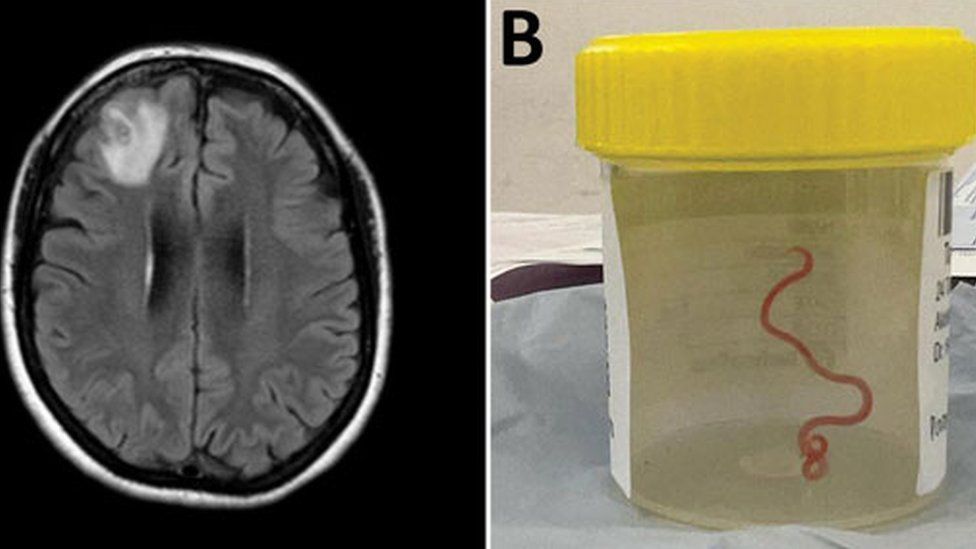In a world-first, scientists say an 8cm (3in) worm has been found alive in the brain of an Australian woman.
The “string-like structure” was pulled from the patient’s damaged frontal lobe during surgery in Canberra last year.
“It was definitely not what we were expecting. Everyone was shocked,” said operating surgeon Dr Hari Priya Bandi.
The woman, 64, had for months suffered symptoms like stomach pain, a cough and night sweats, which evolved into forgetfulness and depression.
She was admitted to the hospital in late January 2021, and a scan later revealed “an atypical lesion within the right frontal lobe of the brain”.
However, the cause of her condition was only revealed by Dr Bandi’s knife during a biopsy in June 2022.
The red parasite could have been alive in her brain for up to two months, doctors said.
The woman, who lived near a lake area in south-eastern New South Wales state, is recovering well.
Her case is believed to be the first instance of a larvae invasion and development in the human brain, researchers said in the Emerging Infectious Diseases journal which reported the case.
‘I pulled it out… and it was happily moving’
The neurosurgeon who found the worm said she had only begun to touch the brain part that had shown up strangely in the scans when she felt it.
“I thought, gosh, that feels funny, you couldn’t see anything more abnormal,” said Dr Bandi.
“And then I was able to really feel something, and I took my tweezers and I pulled it out and I thought, ‘Gosh! What is that? It’s moving!”
“Everyone was shocked. And the worm that we found was happily moving, quite vigorously, outside the brain,” she said.

She then consulted her colleague Sanjaya Senanayake, an infectious diseases expert, on what they should do.
“Everyone [in] that operating theatre got the shock of their life when [the surgeon] took some forceps to pick up an abnormality and the abnormality turned out to be a wriggling, live 8cm light red worm,” said Dr Senanayake.
“Even if you take away the yuck factor, this is a new infection never documented before in a human being.”
Researchers warn the case highlights the increased danger of diseases and infections being passed from animals to people.
The Ophidascaris robertsi roundworm is common in carpet pythons – non-venomous snakes found across much of Australia.
Scientists say the woman most likely caught the roundworm after collecting a type of native grass, Warrigal greens, beside a lake near where she lived. The area is also inhabited by carpet pythons.
Writing in the journal, Australian parasitology expert Mehrab Hossain said she suspected the woman became an “accidental host” after using the foraged plants – contaminated by python faeces and parasite eggs – for cooking.
“The invasion of the brain by Ophidascaris larvae had not been reported previously,” writes Dr Hossain.
“The growth of the third-stage larva in the human host is notable, given that previous experimental studies have not demonstrated larval development in domesticated animals, such as sheep, dogs, and cats.”
Dr Senanayake – who is also an associate professor of medicine at the Australian National University (ANU) – told the BBC the case is a warning.
The ANU team reports that 30 new types of infections have appeared in the last 30 years. Three-quarters are zoonotic – infectious diseases that have jumped from animals to humans.
“It just shows as a human population burgeons, we move closer and encroach on animal habitats. This is an issue we see again and again, whether it’s Nipah virus that’s gone from wild bats to domestic pigs and then into people, whether it’s a coronavirus like Sars or Mers that has jumped from bats into possibly a secondary animal and then into humans.”
“Even though Covid is now slowly petering away, it is really important for epidemiologists… and governments to make sure they’ve got good infectious diseases surveillance around.”

